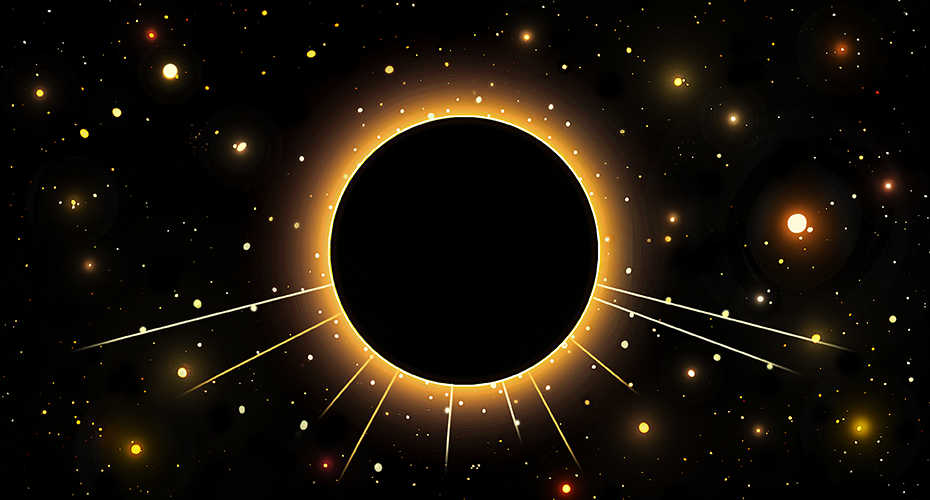To create Expanding Universe, Woonam Kim explored the integration of art and technology, experimenting with augmented reality and mixed reality to create the piece.
Kim is an associate professor at Emily Carr University of Art + Design (ECUAD). With a background in the visual effects and game industry, she has held various roles at renown studios such as Industrial Light and Magic (San Francisco), Digital Domain (Vancouver), and Microsoft Game Studios (Seattle). Kim was the lead layout artist at Digital Domain, and his visual effects credits include Star Wars: Episode III, War of the Worlds, Pirates of the Caribbean: Dead Man's Chest, Transformers: Dark of the Moon, Thor, and Ender's Game.
Woonam Kim's Expanding Universe was on display in our Aurizon Atrium in 2018.
What inspired you to instigate this art project?
When the city of Daejeon held an International Biennale entitled Project Daejeon 2016: Cosmos, I was invited to contribute art that explored the cosmos, utilized science and technology, and carried an educational message for children. 3D computer animation and augmented reality proved to be a great medium for the artistic expression of themes related to the universe.
Expanding Universe focuses on the themes of curiosity and growth. What are you hoping people who interact with this artwork take away from the experience?
While working on the project, I personally learned a lot about the science of the universe, including subjects like dark matter, black holes, string theory, etc. Humans as individuals have a truly small existence in comparison to the magnitude of the universe. Despite our seemingly trivial existence, I am constantly amazed at the human ability to imagine and create. Everything we know today about the world and the universe would not have been possible without human curiosity and imagination. I hope that Expanding Universe provides the audience an opportunity to ponder about the universe, art, and emerging technology. My goal is also for viewers to have fun while experiencing augmented reality art.
This work was a collaboration between you and a group of students. Can you tell us a little about the process you took?
As education has a vital role for the growth of the art community, I instinctively wanted to share this opportunity with my students. I selected students and recent graduates from my class, and we worked through the entire 3D computer animation and augmented reality production processes, which included concept development, modelling, animating, lighting and rendering, and exhibition set up in Daejeon, South Korea.
How did this collaboration affect the outcome?
3D computer animation / augmented reality production is undoubtedly a labour intensive and collaborative process. While an individual could theoretically create this kind of project by him or herself, it would take an overly extensive time to complete. Despite the short production time imposed on us, our team was able to complete the work on time through collaborative efforts and organization. Ultimately, my students gained valuable production experience during the project, and they were excited to visit another country at the end of the process. The project outcome was not limited to the creation of art. While we were in Korea, my students had the opportunity to meet leading artists from Europe, Asia, and the United States, as well as attend various events such as the Joint Workshop of Art & Animation Colleges in Korea, Canada and U.S.A., which I organized with Content Korea Lab. My team also visited various digital media-related art institutes and government organizations. Of course, they could also enjoy Korea’s culture and food.
What excites you about digital art? Are there any digital artists or works that inspire you?
Digital art, which includes 3D computer animation, is constantly evolving alongside emerging technology, which is why technology like augmented or mixed reality is always at the cutting edge and forefront of the digital art medium. There is potential for one to become a pioneer in this new territory, which is why I encourage students who wish to pursue the arts to explore digital art. Digital literacy has made and will continue to make a huge impact on our lives, just as digital art can provide a great opportunity for young artists to become entrepreneurs in this new creative field. It is difficult for me to say which digital artists or works inspire me. I am inspired by many people, technologies, stories, and facets of nature. We are fortunate to live in such a time and be surrounded by many kinds of inspiration in every corner of our lives.
In your view, what is the relationship between science, technology, and art?
Art, science, and technology appear to have their differences; however, these subjects are strongly connected and complement each other in a way that is reminiscent of the Renaissance period. When it comes to computer graphics and 3D computer animation in particular, art and technology are truly intertwined, as they are often delivered as one unit. When balance is achieved between science, technology, and art, it can be truly inspiring and life changing. There is no doubt that these areas will continue to influence, challenge, and inspire each other, as well as bring us to a new level of discovery and innovation.
Science parallels art as a subject matter and a source of inspiration.
Here at Science World, we are delighted to work with local artists who are interested in and inspired by science. Check out our latest exhibits.
